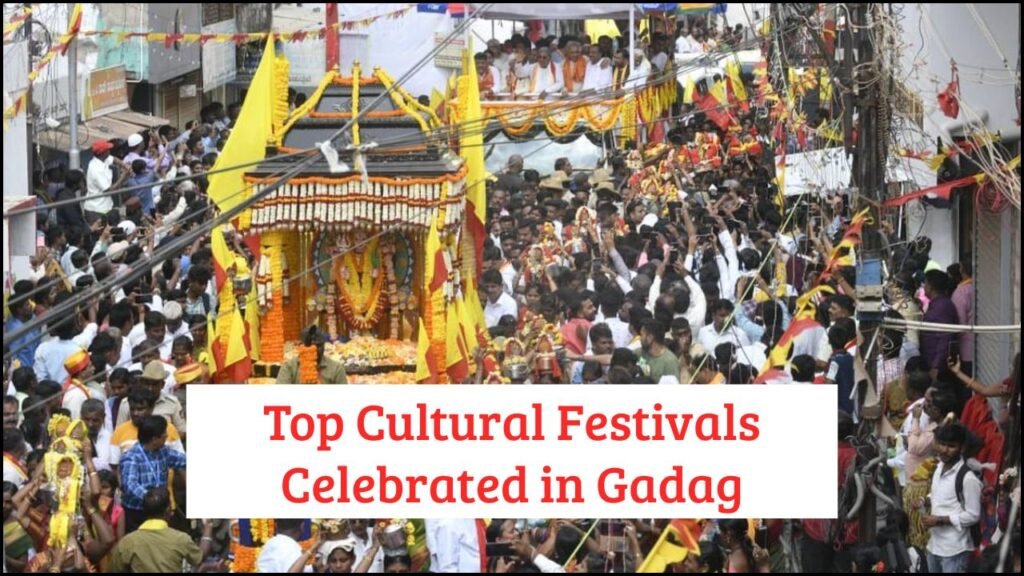
Gadag is not only known for its architectural marvels and historical temples but also for its rich cultural celebrations. The town reflects the vibrant traditions of North Karnataka through its unique festivals that blend devotion, art, and folk culture. Each event in Gadag highlights a part of its cultural identity, attracting locals and visitors alike.
Table of Contents
Major Cultural Festivals in Gadag
1. Veeranarayana Jatre
- Significance: Honors Lord Veeranarayana, the presiding deity of the Veeranarayana Temple
- Venue: Veeranarayana Temple, Gadag
- Time of Celebration: March-April (Chaitra month as per the Hindu calendar)
- Key Attractions:
- Chariot procession of the deity
- Classical music and bhajans
- Folk dances performed by local artists
2. Basaveshwara Jayanthi
- Significance: Marks the birth anniversary of Basavanna, a social reformer and philosopher
- Venue: Basaveshwara temples and community halls across Gadag
- Time of Celebration: April or May
- Key Attractions:
- Processions with Basavanna’s portrait
- Public speeches on his teachings
- Distribution of prasada (sacred food)
3. Mallikarjuna Jatre at Korlahalli
- Significance: Celebrates Lord Mallikarjuna, an incarnation of Lord Shiva
- Venue: Korlahalli village, Gadag district
- Time of Celebration: January-February
- Key Attractions:
- Ritual performances
- Bullock cart races
- Community meals (Anna Dasoha)
4. Doddammadevi Jatre
- Significance: A festival dedicated to the village deity, Doddammadevi
- Venue: The Surrounding villages of Gadag, like Lakkundi and Ron
- Time of Celebration: Varies by villa,ge but typically post-harvest
- Key Attractions:
- Traditional folk performances
- Ritual animal processions
- Worship and temple offerings
5. Ganesh Chaturthi
- Significance: Celebrates the birth of Lord Ganesha
- Venue: Throughout Gadag in homes and public mandals
- Time of Celebration: August-September
- Key Attractions:
- Artistic Ganesh idols
- Cultural competitions and music
- Immersion procession (Visarjan)
Festival Highlights and Features
| Festival | Special Rituals | Cultural Programs | Local Foods Offered |
|---|---|---|---|
| Veeranarayana Jatre | Flag hoisting, temple puja, Rathotsava (car festival) | Classical singing, Harikatha storytelling | Sweet pongal, lemon rice |
| Basaveshwara Jayanthi | Group prayers, Basava Vachana recitals | Speeches on Basava philosophy, youth activities | Kesari bath, kosambari salad |
| Mallikarjuna Jatre | Early morning abhishekam, flower offerings | Folk songs, dance dramas, wrestling competitions | Jowar roti, chutneys |
| Doddammadevi Jatre | Animal worship, garlanding village deity idols | Puppet shows, village orchestra (janapada) | Holige, rice payasam |
| Ganesh Chaturthi | Daily aarti, Ganesh puja, and modak offerings | Bhajan evenings, fancy dress, and quiz contests | Modak, sundal, vade |
Traditional Music and Dance Forms
1. Dollu Kunitha
- Origin: Performed by the shepherd community
- Description: Drum dance involving synchronized group movements
- Appearance: Dancers wear bells and colorful costumes
- Occasions: Seen in Basaveshwara Jayanthi and village jatres
2. Janapada Geethegalu
- Type: Folk songs in Kannada
- Themes: Nature, love, farming, and divine devotion
- Instruments Used: Harmonium, tabla, flute
3. Veeragase Dance
- Representation: Symbolizes the valor of Shiva’s devotees
- Performers: Mostly male dancers with dramatic expressions
- Typical Costume: White dhoti, red waistband, jewelry, and headgear
Local Involvement and Traditions
Community Participation
- Women decorate homes and temples with rangoli
- Youth groups form cultural teams to organize programs
- Elderly narrate traditional tales and guide rituals
Religious Unity
- Many festivals witness participation across caste and community lines
- Local mosques and churches also celebrate their events with equal grandeur, enhancing the town’s cultural fabric
Educational Impact
- Schools organize competitions during major festivals
- Children perform skits on historical and mythological characters
- Teachers explain the cultural and spiritual meanings behind each festival
Role of Temples in Festival Celebrations
| Temple | Festival Associated | Special Activities |
|---|---|---|
| Veeranarayana Temple | Veeranarayana Jatre | Rathotsava, Vedic chanting |
| Basaveshwara Temple | Basaveshwara Jayanthi | Recitation of Vachanas, Deepotsava |
| Mallikarjuna Temple | Mallikarjuna Jatre | Night-time puja, fire torch rituals |
| Local Village Shrines | Doddammadevi Jatre | Animal blessings, festival fairs |
| Ganesh Mandals (temporary) | Ganesh Chaturthi | Idol installations, cultural evenings |
Seasonal and Agricultural Influence
Post-Harvest Celebrations
- Doddammadevi Jatre usually occurs after the harvest
- Farmers offer the first produce to the deity
Monsoon and Ganesh Chaturthi
- The rainy season coincides with Ganesh Chaturthi
- Locals thank the rain gods for a good crop year
Spring and Temple Jatres
- Veeranarayana Jatre happens in spring, symbolizing renewal
- Ideal weather allows large outdoor gatherings
Preservation and Promotion of Culture
Cultural Clubs and Societies
- Local NGOs promote folk dances and rituals
- Cultural programs in schools teach children about festival traditions
Government Support
- Karnataka tourism promotes temple fairs and jatres
- The district administration provides security and sanitation during major festivals
Artisan Participation
- Local artists make clay idols and decorations
- Weavers and potters display handmade crafts during festival fairs
Looking Ahead
Festivals in Gadag are not mere celebrations but living symbols of its heritage, values, and identity. Each event brings the community together in a spirit of devotion, joy, and shared culture. Through traditional arts, temple rituals, and local flavors, Gadag continues to preserve its rich cultural legacy for future generations.





